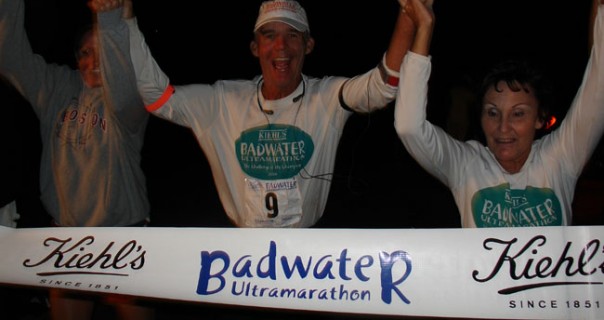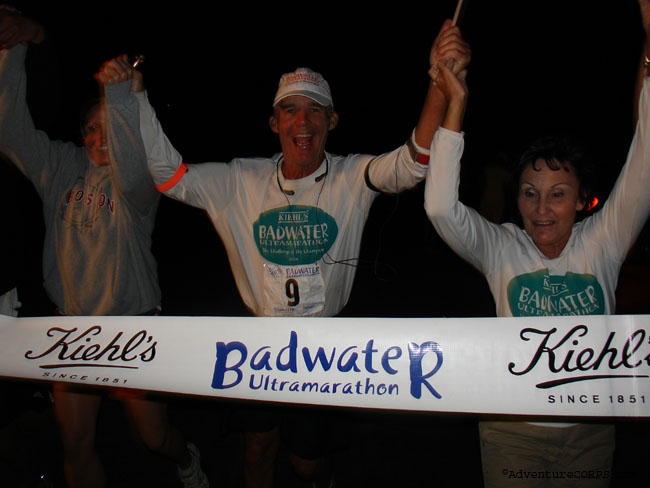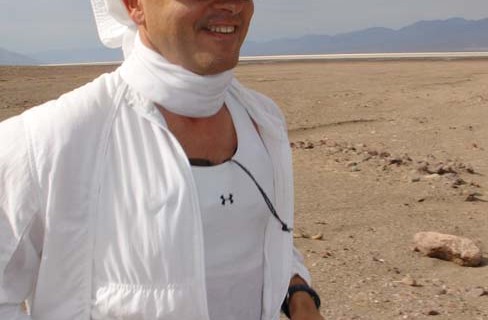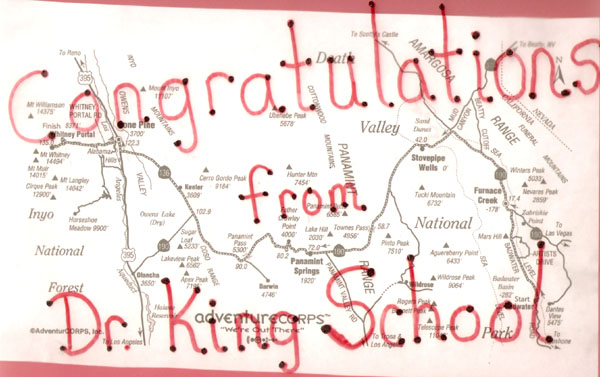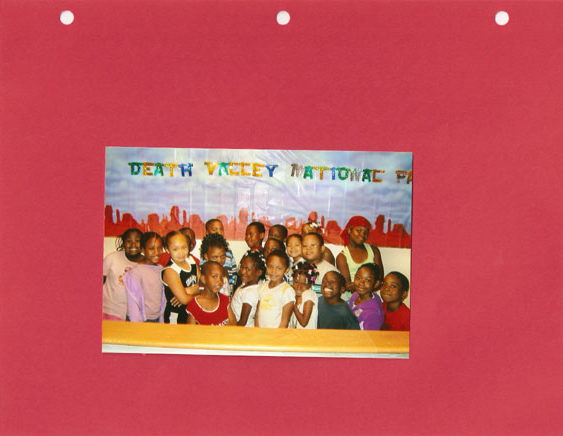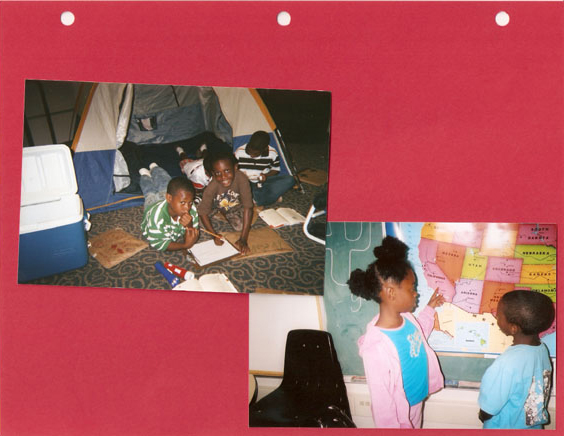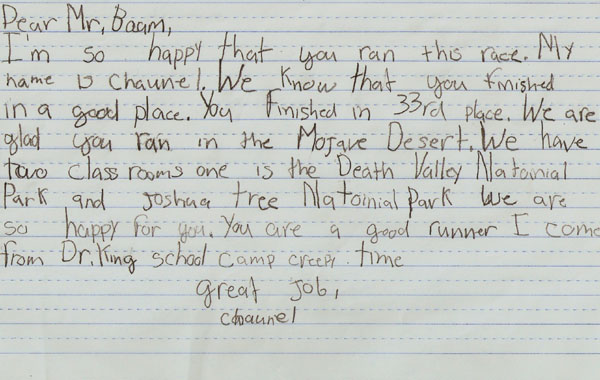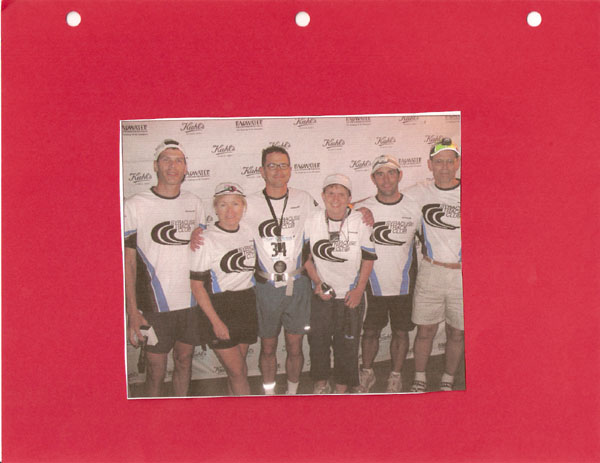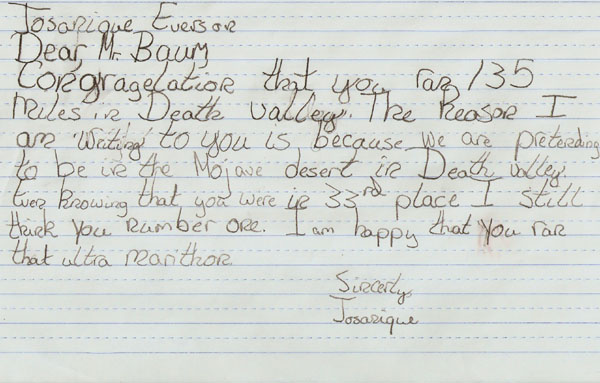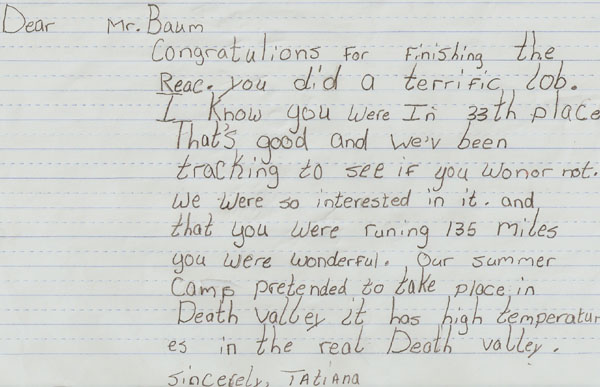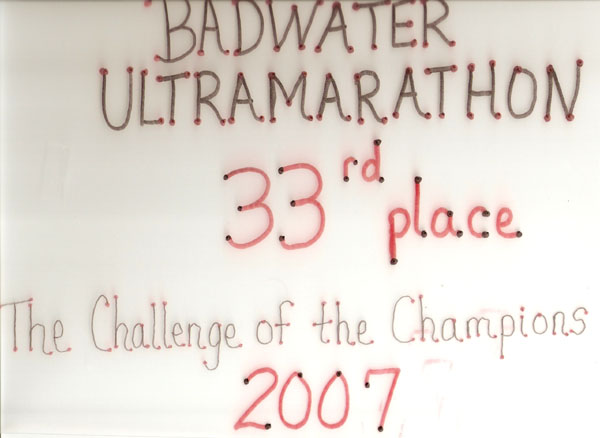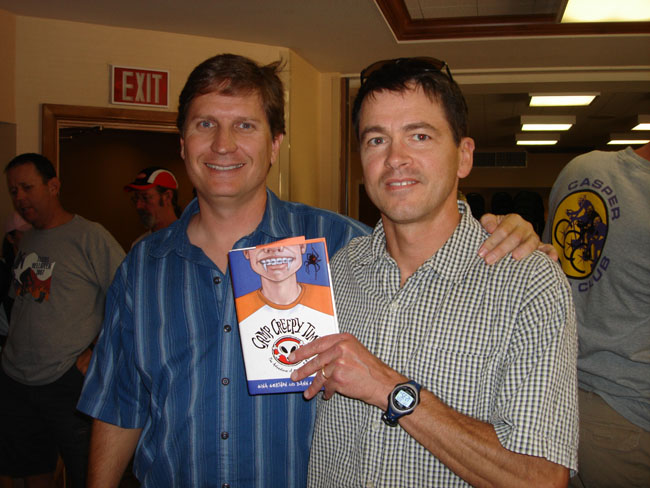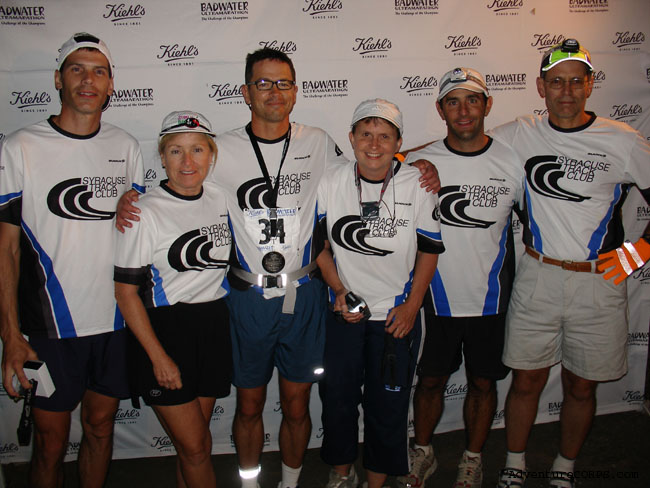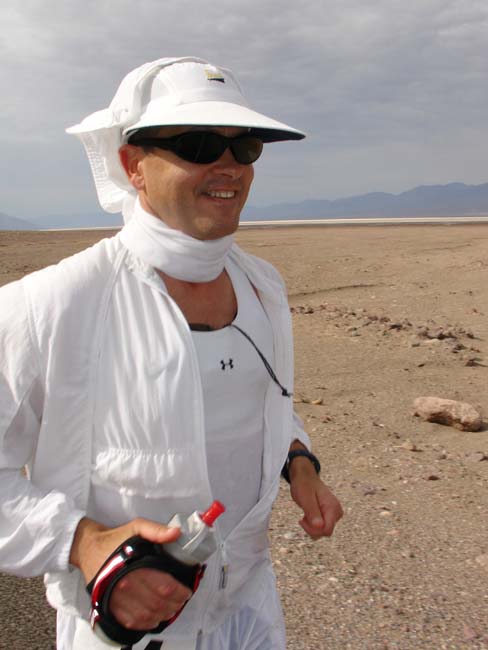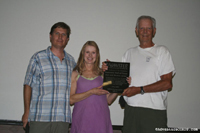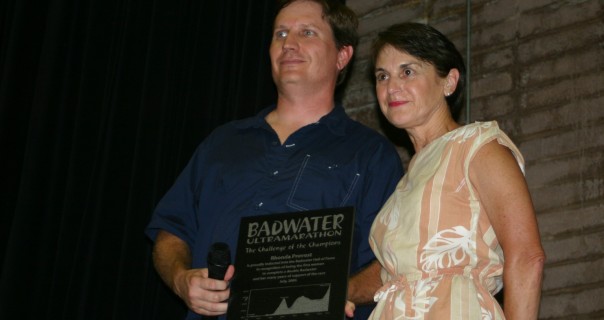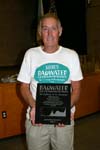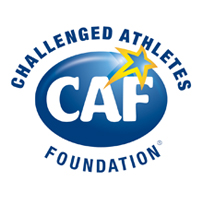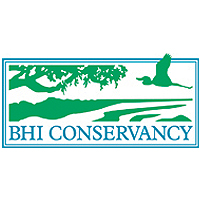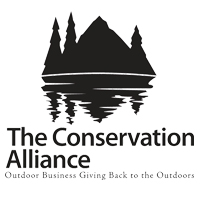Crew person for 2008 finisher Phil Rosenstein
I returned to Death Valley again this year not knowing if it was love that brought me there or if was it there that I found life. This is where I learned to believe that things don’t have to be seen to be true. It’s where I found the strength to open up my heart and trust those around me. It was here in the desert where I realized how precious life is and how to live each moment for what it is.
This year I was given an opportunity to take the hands of those around me to share a wonderful experience. Together we would bond to guide one runner 135 miles through the desert so that he too could experience the life changing affects of a Badwater finish.
Though ability and mental toughness are needed to complete a race of this type emotional support and guidance are just as critical. Phil selected an outstanding crew of which I was flattered to be a member.
It was not the athletic background of the crew members that allowed us to bond but instead it was the human element that brought us together as one.
Elizabeth Carrion, the only female member of Phil’s crew, played the role of mentor and motivator. She was commonly referred to as “the other girl” or her.” These nicknames were bestowed upon her by Dave Yeakel who for some reason could never remember her name. Elizabeth advised Phil on the importance of nutrition amongst other things. She certainly demonstrated the ability to convey a message authoritatively but also compassionately. Phil is quite a stubborn guy so though he listened I doubt that he learned much, however, her presence certainly seemed to motivate him in times of need.
Ted McMahon the “normal” one of the group was a very calming influence. I was concerned that he would feel out of place but in fact he fit in very well. His calming demeanor brought tranquility to an otherwise brutal arena. Ted, the perfect gentlemen, kept our group composed even through the most difficult circumstances.
Dave Yeakel, one of Phil’s closest friends, played the role of comic relief. His meticulous though gentle personality left him an easy target in our group. His passion is running but it was his love of food that left him with the name of “Subway” Dave. His role was that of communicator and organizer. He spoke the raw truth to Phil and was able to manage the emotions associated with a negative outcome. Though he knew that he could be a target of Phil’s frustration Dave was never afraid to communicate his feelings because he was confident that in the end it would be helpful.
Me? Well I was deemed the crew leader by Phil. I have to admit that I had no problem fulfilling the duties associated with that title but I certainly felt uncomfortable being labeled as such. It was not the role that bothered me but instead it was how the others would react to the title itself. Leaders in general do not need official recognition but instead they just lead. Phil felt it necessary to announce to the group that I was the leader and that they were to take direction from me. This announcement made me feel very uncomfortable for it is not one person who leads the runner to the mountain but instead it is the strengths of the entire group who do so. I took Phil’s announcement in stride but later I told the rest of the crew how I felt. I assured them that I would certainly give guidance if needed but equally together we would lead as a group.
Phil Rosenstein is as tough as they come so I had no doubt that he would finish, however, I was just as certain that he would experience challenges that he never before faced. You see in March of ’08 Phil contracted pneumonia which became complicated by and infection requiring a thoracotomy to drain fluid from his lungs. As the days to the race neared and others trained hard he laid in bed wondering if he would ever run again. Months behind his peers he did his best to prepare and amazingly enough at 8 a.m. on July 14, 2008 Phil Rosenstein confidently stood at the start line of the Badwater Ultramarathon.
The night before the race Elizabeth, Dave, Ted and I held a meeting to develop a plan of action. The first order of business was to determine a time that we should leave our hotel and the second order of business was to discuss crew assignments. I expressed how important it would be for us to arrive early so that we could implement our crewing strategy without a hitch. I emphasized how critical it would be to gain a front row parking spot so that we could not only see the start but also have immediate access to our vehicle. This would give us the extra time to stage ourselves exactly one mile away so that we could prepare for Phil’s arrival. A good parking spot would allow us an easy exit so that we could get properly staged to assume our duties as crew without mass confusion. The duties that needed to be addressed were driver, water bottle attendant and ice bandanna manager. The plan that we developed included staging one person 20 yards from the van to greet Phil with a fresh water bottle while a second person stood parallel to the van ready to replace his ice bandanna and a third would then offer food and spray him down with water. The fourth person of the group would be expected to drive the vehicle and document consumption. I suggested that we not deviate from our assigned tasks until we reached Furnace Creek. I felt this would help us get into a nice rhythm so that things would flow smoothly from there.
Phil arrived at the starting line very upbeat and anxious to run. The first thing that he did was to seek out the University of Montana research team. As a participant of their study Phil was required to weigh in, give blood, and swallow a pill that would be used to measure heat transfer in his body. We were aware of these requirements prior to the race and planned accordingly to allow time.
While Phil checked in I noticed a race official observing the signage attached to our vehicle. We were certainly in compliance with the requirements as far as the dimensions of the lettering but the race officials were not completely satisfied with the visibility of the lettering. I understood why we were flagged because our markings were not consistent with that of the other participants. There were several methods being used by the others to identify the vehicles with the most popular being shelf paper or magnets. Phil, mirroring my mistake in 2006, chose to mark his vehicles with poster board. I can relate to Phil’s difficulty in nailing down the small details of this race as I too was injured right up until the day that I ran Badwater in 2006. As it turns out he was just as lucky as well because he too had a crew who reacted without any undo stress to him.
Using poster board to identify the vehicles is fine however clean-up afterwards can be quite difficult. My crew in ’06 found that the duct tape used to attach the signs can and will melt in the extreme desert heat. In order to avoid this kind of a messy clean-up “Subway” and I came up with an alternative approach. Our first choice was to use shoe polish to write Phil’s name and number on the vans but when that couldn’t be found we opted for a bar of soap. We wrote clearly using large letters but they were deemed not visible by the race official who inspected our vehicle. Since Dave and I had left the poster board signs in the van it was an easy fix and in the end the clean-up was easier than expected.
The unseasonably cool temperatures along the banks of the salt slicks may have fooled those in the group in to believing that this would be an easy run. Soon, however, they would find that there is nothing easy about Badwater. What this day may have lacked in heat it would make up in other unknown challenges along the 135 mile course.
The 30 or so runners that stood at the start line could have possibly been considered the bravest people on Earth. The scenery on the right included nothing more than a mountain with a sign indicating that they stood 282 feet below sea level while on the left was the lonely desert and directly ahead was an endless road.
The pre-race ceremonies included a group photo, a lively talk by Chris Kostman and the National Anthem. Some have found the pageantry associated with the race objectionable but personally I find it quite exciting and deserving of a World Class event. Despite all of the pomp and circumstance leading up to the race the actual start was unpretentious. The group counted down from ten and when they reached zero the race began.
Phil started out running in the lead pack and looked strong. While I have no doubt that the cool temperature and the breeze dictated the early pace I’m just as certain that the emotion buried deep inside of his heart contributed as well. There are photos of Phil at the starting line looking into the sky while attempting to hold back tears. Though I never asked and never will I can’t help but wonder what his thoughts were at that very moment.
I’m usually an advocate of allowing emotions to flow freely during a run but in Death Valley it might be best for the runner to keep them in check. The Valley is a living Hell and the Devil is waiting to capitalize on any mistake that a runner might make. This particular day Phil went out fast and furious while confidently pushing hard. The Devil saw a naïve young man and tricked him by including high humidity with the low temps. The elements took an early toll and before Phil realized what was going on the Devil had already threw his first knockout punch.
Our strategy of meeting Phil at every mile was working well but as his condition deteriorated we scrambled to help him survive. We as a crew knew Phil’s background well and because of that we never panicked when he dropped to both knees at mile 10. The Valley threw a hard punch but like any good fighter Phil rose to his feet and asked for another.
I would be lying if I said that I wasn’t shocked to see him take a knockout blow so quickly. It turned out to be a wake-up call to all involved that this would be a battle from mile one until the very end.
At the 10 mile mark Phil stopped, bent over, and released the contents of his stomach while falling to the ground. Ted and I reached down to help him to his feet and lead him to the air conditioned vehicle where he sat quietly for a moment. Phil never once looked concerned but instead he seemed to take it in stride. He sat for only a short time before stubbornly rising to his feet to return to the road. His mind was sharp but the Valley’s first assault had left a mark on his body. I pleaded with him to stay in the vehicle for a few more minutes but he refused.
He was stubborn but he was stubborn for a reason, a reason which he never explained until later in the race. Some people gain motivation from family, religion, childhood memories (both good and bad) and even heartbreak but Phil was motivated by a dream a dream that he believed would be out of reach if he sat for even a moment’s time. I have no doubt that this dream occurred as he lay in a hospital bed all alone for several weeks in the early spring. I can’t possibly begin to understand what his thoughts were as he lay in that bed but what I can understand is the internal drive to satisfy a deep need to prove something not just to himself but to those who did not believe in him. It was because of this that a finish would not be acceptable unless he did so within a certain time period.
Before allowing him to leave the vehicle I appealed to his good senses by providing a definition of heat exhaustion. Since his mind was sharp I had hoped that he would understand the consequences that he could suffer if he continued. He stared at me as I spoke so I knew that he heard my words but I was just as certain that because he was so focused he did not comprehend the message that I tried to convey. As soon as the last word left my mouth Phil was on the road again. When he left Elizabeth observed his movements and quickly brought it to our attention that his running form looked unstable. Before I could even look back Phil had already stopped running and started to double up in pain. When we retrieved this time we insisted that he sit in the car for at least 15-20 minutes. I then personally tried my best to convince him that what he was suffering from heat exhaustion and that when he cooled down his body would start processing fluid instead of rejecting it. Instead of placing trust in me he complained about the period of rest that was forced upon him.
While he sat we increased the intensity of the air conditioner and placed ice around his neck. I had hoped that this would be enough to lower his core body temperature and bring him back to life. I had no way of knowing that this scenario would be indicative of what our days would be like and actually I’m thankful that I didn’t.
Before Phil left I tried to redirect his thoughts. I wanted him to focus on time instead of mileage. I stressed the importance of taking it easy during the day so that his body could begin to function as it should. I reminded him how cool it would be at night and how much better he would feel which would allow him to give a better effort. The message that I sent was for him to focus on the night as he ran slowly through the day.
I believed in what I told him but I wasn’t sure that Phil would ever be willing to trust me enough to relinquish control. The battle between Phil and Death Valley had just begun and now it was evident that it would be complicated by the battle that was going on between Phil and his own mind.
The last direction that we gave Phil prior to allowing him to return to the course was to move forward slowly. This would be the only way that he could gain ground while recovering from the effects of the elements and the early fast pace.
Dave, Elizabeth, Ted and I were so in sync that there was no need for a group discussion as to how we should proceed. We observed his movements as he met us at each mile and we asked simple questions that would help us to determine his condition. It was crucial that we remain patient and wait for marked improvement before offering solid food. At 131 pounds with very little body fat it was critical that Phil start eating to gain energy to fuel his body. Battle number three came in the form of persuading Phil to eat.
Phil confessed his distaste for food well in advance of the race but for some reason I never realized that this could be a problem. I did, however, have some concerns when he explained to us how he planned to maintain his energy level. We doubted that he could survive off of a steady diet of Perpeteum and gel but he knew his body best so we had to trust him. His microscopic pre-race meal also raised some concern but again we had to trust that he knew what he was doing.
It became clear by the third mile that Phil was not going to concern himself with nutrition so eventually we would have to step in. The bottle of Perpeteum, which was handed to him at the two mile mark, was barely touched through ten miles. This most certainly contributed to his rapidly failing condition. Though I was concerned and even frustrated that Phil was not eating I understood why. I honestly believe that he was so focused on running that he literally forgot to eat. I understand how this could have happened because I too have experienced similar emotions resulting in irrational decisions. The power of the mind can trick the body into believing it can conquer anything with little help. That’s why it is good to have a support team or crew to care for your needs.
Phil started looking better at the thirteen mile mark so it was at that time that we made our first attempt at offering food. We were hopeful that his body would now start processing some light food and fluids. His main complaint about the food was that it was dry and hard to swallow. Despite his complaints we began by offering him solid food such as ‘Nilla Wafers, Doritos, and his early favorite baby smoothies. Every small bite was a success and as such I praised him highly. I was hopeful that the positive reinforcement would result in him asking for more food. It was probably deceitful of me to try to get him to respond in a certain way to a particular stimulus but I was looking for anything that would work.
I laugh now as I look back because our interactions were quite similar to that of what we would have with a little child. First we would offer the food and with a disgusting look upon his face he would shake his head no. Once convinced to take the food he sometimes swallowed and sometimes spit it right back out. Finally, when we were certain that he consumed even the smallest amount, we offered praise in hopes that the stimulation would provoke him into asking for more.
I was thrilled as Phil began to respond and seemed to comprehend the message that we had been trying to send. He slowed dramatically yet moved forward consistently while accepting and even requesting food.
Phil is a very direct person who speaks most times in a monotone, authoritative voice. His requests could have been considered demanding yet I thought it was funny when he yelled “I would like two spoonfuls of mashed potatoes. Not three, not four but two.” Personally if it were me I would just grab the spoon and push down as much as I wanted but Phil wanted exactly two. You will begin to understand as the story develops that Phil thought that he could function as a robot and still survive Death Valley.
Mile by mile Phil progressed slowly toward Furnace Creek which was the first checkpoint seventeen miles into the run. Although I never revealed my feelings to the others I was now genuinely concerned about Phil’s condition. I looked forward to reaching the check point for it would be here that I could gain confirmation as to whether we had reacted appropriately to his symptoms. Upon our arrival at Furnace Creek I quickly sought out the help of a professional to evaluate Phil’s condition. The medical staff first wanted to establish that his lungs were functioning prior to addressing any other issue. You see they were not immediately made aware of Phil’s spring hospital stay until literally hours before the event, however, by the time he reached Furnace Creek four hours into the race the news had already circulated through the entire staff.
At no time did I ever feel that Phil’s breathing was erratic but I understood when Dr. Lisa Bliss suggested that she may issue a warning if she detected a problem. While Phil rested Dr. Bliss left to retrieve a device that she would use to determine if Phil was breathing as he should. I didn’t think that it was necessary to tell Phil that he may receive a warning because I didn’t want to bring on any unnecessary stress but instead I stood by his side and waited patiently for Dr. Bliss to return.
Furnace Creek is a quaint little town where obviously very few people live but many do visit. The small village in the middle of Hell was most certainly constructed to accommodate visitors as opposed to permanent residents. There is a hotel, two nice restaurants and a corner store for just such a purpose. While Phil rested we paid a visit to the corner store to replenish our supplies. In this harsh environment ice was clearly a number one priority at all times for every team involved. That being said the corner store was completely out of ice by the time we arrived. The character of the crew was challenged early on by this news but as would be throughout they met the challenge head on. Instead of panicking someone asked if ice could be found somewhere else close by. The clerk directed us a quarter of a mile down the road where ice was sold in bulk and readily available. After we sorted out this problem Dr. Bliss performed the test and was satisfied by the results however she us direction to monitor his condition and warned that he would be pulled if things digressed.
As part of my preparation as crew I had promised myself that Phil and the entire crew would arrive safely at Mt. Whitney. I was confident when I assured Lisa that Phil would be okay.
In our pre-race discussion we concluded that it would be best for Elizabeth to be the first to pace Phil out of Furnace Creek. In retrospect we should have discussed this further and developed an alternate plan considering all possible scenarios. Phil obviously struggled through the first seventeen miles of the race so what he needed now was the calming influence of Ted. However the crew was operating like a well oiled machine with each member executing flawlessly and as such Elizabeth immediately assumed her duties as pacer.
The purpose of the crew was to support Phil so we agreed that it would be best to limit pacing duties to three mile stretches. This would allow each of us to stay fresh physically and sharp mentally so that we could make the best possible decisions in times of crisis. Though it may be cool to come home and tell your family that you ran fifty miles in the desert would it be okay to do that at the expense of your friend? That was the question that had to be asked.
Elizabeth had a knack for brightening Phil’s spirits while pushing him to his limits. The energy that she exudes is contagious and clearly Phil became a victim of the disease. His facial features were now of a man intensely running with a purpose. It was still very early in the day and Phil did not seem confused by his actions so I did not intervene. I did, however, believe that his level of activity would certainly have some adverse effects. I decided early on that it would be best to allow Phil to suffer at his attempt at consistency so that when we took over later in the race he would be cooperative. As he ran I resumed my duties as water boy while Ted took charge of the food and ice bandannas and Dave drove.
Phil’s stint with Elizabeth ended with him smiling and feeling lively. His mood and energy level were on the up rise but still I wondered if the effort put forth was too much too soon. The answer came quickly in the form of Phil doubled up in pain as he and Dave arrived at the twenty-one mile mark. He had been thrashed around like a rag doll all day by the heat, humidity and stress associated with the event. A tactical error was definitely made by assigning Elizabeth as the first pacer but the effects of our mistake could have possibly been minimized or even eliminated by deviating from our plan. I started to question if the strategy we had employed was also a contributing factor to his early struggle. I recognized the change in Phil’s mood while in Elizabeth’s presence but I remained committed to our plan. I quickly resolved this conflict in my own mind because I sincerely believed that over the long haul our plan was best. Our plan being to regularly rotate pacers in and out every three miles so that each would remain physically and mentally sharp all of the way to the finish.
Dave Yeakel and I evaluated the rotation of the pacers as Phil rested at the twenty one mile mark. We both believed that it would be important to identify the strengths of the crew so that they could be best utilized in times of need. Elizabeth’s strength was her contagious energy level so she would be best used when Phil was feeling good and not too worn down. My initial feelings were that she should join him on the down hills especially the nine mile stretch into the Panamint Valley and also up the mountain to the finish line.
Ted was someone who could stimulate him intellectually bringing sense to every reason as to why he was there. He would be best used in times of doubt and struggle.
Dave was a person with whom Phil could rely upon to share his real feelings of doubt and pain. While conversations like these in normal races can drain energy stores it is important in a race of this distance for to have an outlet for those feelings. It would not be good to allow Dave to pace during a death march but certainly he could step in and contribute at any other time.
My strong point is creating an environment where the other person becomes aware of his or her contributions and accomplishments. It is human nature to look at other people and focus on what he or she has done while never considering what you have done. Communicating effectively would help him to recognize his own strong points resulting in improved self esteem and a higher level of confidence both of which generate positive energy. I would best be used when Phil was down and out or upon his request.
We had the good fortune of being visited several times by the medical staff in the miles leading from Furnace Creek to Stove-Pipe Wells. I was comforted by the fact that they were there to support us, however, I felt uncomfortable when they stopped to question us. The drive-bys were simple as I could nod and confidently wave but when they stopped I felt as though I were a suspect being interrogated by the police. Though flustered I was confident in my ability to reassure the staff that Phil was okay. In fact Phil never suffered from anything that anyone else wasn’t suffering from in the Valley. The purpose of the routine visits was not to make sure Phil wasn’t throwing up or that his feet weren’t blistering but instead the purpose was to gain reassurance that his ailments were not complicated by an inability to breathe. I was amazed by the amount of attention that Phil received but later it became clear why when I found that he was expected to be an early drop. As I look back upon the race I can’t help but cringe because I never once considered his respiratory issue to be a major concern. I was aware and I observed but never once was I concerned and maybe I should have been.
The desert setting leading to Stove-Pipe Wells was not much different to that of the first seventeen miles. In my heart I see the beauty of the area but my mind recognizes the brown, ugly foliage and rough dirty sand that personifies the suffering experienced by the runners. In the distance on both sides mountains can be seen but directly ahead lay a long, flat road with seemingly no end.
The desert sky was covered with clouds a sure indication that the weather in the area could change at any moment. In fact, unknown to us at the time, a severe storm was pounding the little town of Darwin destroying the only road leading into Lone Pine. The resulting destruction led to a devastating decision to reroute the race course. In late June Mother Nature had taken it upon herself to rob over three hundred runners of an opportunity to race through the Sierra Nevada Mountains and now she threatened to steal the Mt. Whitney finish from over eighty Badwater Ultramarathon participants. Since the road leading into Lone Pine was inaccessible the race director had no other choice but to reroute the runners back to Panamint. It was only an incredible response by the highway clean-up crew that his decision was reversed allowing the race to continue on through Lone Pine and up Mt. Whitney to finish without a hitch.
Phil was not made aware of the medical visits or the troubles in Darwin. It was our job to manage the burdens on the outside and his to manage the burdens on the road. Though I never believed that he was in serious trouble he continued to struggle in several ways. He refused to eat and moderate his pace, and was unwilling to stop for even the shortest period of time. I failed in my attempt to get him to recognize how important it was for him to regulate his body temperature and what the consequences could be if he continued to fail. I’m certain that his refusal to eat was no indication of his regular habits but instead it was the result of heat exhaustion. He complained of sloshing in his stomach and was convinced that it was due to lack of salt but again I could not convince him that this symptom was the result of overheating. His decisions were poor both generally and strategically. The power struggle continued but I was not as willing to allow him to gain control as I was earlier in the day. The early knockout blow was shocking but the fact that he refused to reevaluate and respond made it frustrating as well.
Phil’s kind heart was revealed in the miles leading to Stovepipe Wells when he demanded that we address the needs of a struggling runner directly behind. Once we tended to Phil’s needs we turned our attention to the lone runner which Phil made mention. He was moving slowly without a crew vehicle in sight and there was no doubt that he was suffering. He looked disoriented and was sweating profusely. I tried communicating with him but found that he did not speak English but through some hand motions and gestures I was able to offer him a couple of Succeed tablets. Phil pointed out that he had symptoms consistent with a lack of salt and after observing his movements I agreed. He took the two tablets that I offered and then pointed ahead as if directing me to his crew. Sure enough his crew vehicle came in full view as we moved forward. When we reached his support team I found a person that could speak English and I told her what I had given her runner and offered her a couple of more tablets for later. They were thankful for our help and later took photos of our group as a way to fondly remember us. I found out later that Erhard Weiss went on to finish Badwater in a time of 50:26:24.
Those who don’t know Phil can come to some early conclusions which may not necessarily be true. He is certainly a person who is very independent and as a result may find it hard to trust those around him. His tone of voice and the way he expresses himself are not indicative of what is in his heart. I believe his independent nature has found him alone for long periods of time seeking attention and that there may be times that he deliberately searches for the spotlight. Ultrarunning is a sport where mental toughness rises above athletic ability and completion of a race is just as impressive as winning. He thrives in this arena because his physical ability is only average amongst the best but he is tougher than most. An ultra long distance run provides a place where Phil feels most comfortable and a place where he can be a leader amongst his peers and gain the admiration that he seeks.
I took the last 3 mile leg into Stovepipe Wells with Phil as the others traveled into town to get ready for his arrival. Stovepipe would be a place where Phil planned to take a long deserved break in order to prepare for the night time hours. Several times he had expressed a desire to take a refreshing dip in the pool and as we came closer he became more excited.
When Phil got to Stovepipe the first thing that he did was fulfill his duties as a participant of the University of Montana research study. While I escorted him to the medical area the others prepared food and retrieved clean, dry clothes for him to change into. When he was done I led him to the pool where he stripped down and jumped in. While standing there I started a conversation with a photographer that I observed taking pictures of those in the pool. In our conversation I found that he was employed by the LA Times and thought that Phil would be excited to have an opportunity to be photographed by a person representing a major publication. Prior to introducing the two I gave the photographer a quick summary of Phil’s background and told him what his quest was for the day. It was my role to find ways to generate energy from any source possible and I had no doubt that an exciting visit with an LA Times photographer would certainly contribute to his energy stores.
The relaxing spell in the pool relieved his sore muscles and troubled mind but it also ruined the tape that had been applied to his feet to prevent blisters. “Subway” Dave was well prepared for just such an event as he was ready to re-tape Phil’s feet upon demand. Dave, though lighthearted, really took this assignment seriously which gave him some unnecessary stress. Proper tape application is critical for if not done properly it can actually be the cause of blisters instead of a way to prevent them. Dave was very meticulous in applying the tape and as such it took a very long time to do so. He did a very good job and was rewarded with gaining the first opportunity to take some time off to rest.
It was critical that each of us take a turn at resting for at least two hours. Resting was not negotiable as it was a way for us to remain sharp both in our decision making skills and our ability to function safely. Everyone was given an opportunity to select a slot with the first to begin at 8 p.m. I was certain that the first slot would be hard to pawn off because no one really wanted to leave. As a way to avoid conflict I volunteered to take the first shift but “Subway” volunteered to take the slot instead.
After taking a long rest break at the hotel Phil was back on the road by 8:30 and was joined by Elizabeth as they began the trek up to Townes Pass. It would be a slow, grinding 18 mile, 5000’ foot climb to the top of the mountain. Though we were surrounded by darkness the temperature still hovered above 100°. I had promised Phil that the night time skies would bring relief but the Devil had other plans. A headwind forced the heat off of the asphalt directly into Phil’s face mimicking the effect of a blow dryer. Phil complained but I refused to listen. I felt that I had to allow him to overcome this minor challenge on his own for if I stepped in than he would lose the drive to overcome the more difficult challenges later on.
Phil promised the crew a beautiful night time view of the sky but unlike our travels on this same road in “06” the skies were not clear. I made an attempt to provide a description of the seemingly million stars that are so close that you could reach up and grab one. The shadow of the moon in the distance with the reflection of several shooting stars was something to be desired but not found on this night. The conversation passed time but the miles still went by very slowly.
Phil’s pace slowed and his body responded by functioning the way that it should. He became hungry and asked for food for the first time. We gladly responded by offering him everything under the sun. Though we had a large variety of food his favorite was instant mashed potatoes. The food that he requested most was that which was cold and took little effort to swallow. As far as fluids were concerned he consumed mostly water but occasionally he would accept soda and used Pedialyte as his only source of liquid electrolyte replacement. When he was tossing his cookies earlier in the day I’m certain that it was the Pedialyte that saved him.
In the darkness he functioned well but still we continued to weigh him as we did throughout the day. His weight was 131 lbs at the start and remained consistent even through those tough early miles. The darkness seemed to change his demeanor from that of suffering to that of hope. My hope was that it would be an easy, uneventful night.
As “Subway” slept Elizabeth and Ted took turns pacing Phil while I continued to service him at each stop. After a couple of hours and eight miles of progress “Subway” returned. It was now my turn to disappear for awhile. The agreed upon rest times of 8, 10, 12 and 2 had to be modified since we had a late start getting out of Stovepipe. By the time “Subway” got back it was already close to 11 p.m. this left me enough time to get to the hotel, grab a shower, drink an entire pitcher of ice cold water and lay on the bed with my eyes open for a few moments. I also spent some time in the infirmary speaking with a few crew members whose runners were not as lucky as ours. I was going stir crazy about an hour and a half so I jumped in the van and headed back. I figured that Phil was probably moving at about 4 miles an hour so the group would be about 14 miles away. I arrived in less than twenty minutes only to find Phil suffering through another down period.
I relieved Elizabeth so that she could take her break and then I made my way to see how Phil was doing. As soon as he realized that I was back he requested my presence so that he could share a private moment with me. I changed into my night time gear and then made my way out to chat with him. I knew that it was serious because when we met he immediately grabbed my hand and held it tight. What he was about to tell me was not shocking but it certainly challenged my ability to make a good decision. There was no direct eye contact as he spoke and fear was easily recognizable in the tone of his voice. It became evident that for the first time ever Phil feared failure. He didn’t fear injury or death but instead pure failure. I was certain that this was not a physical challenge but instead another battle within his mind. He was accompanied by friends yet he felt alone questioning whether his body would cooperate with his mind. I personally don’t pay too much attention to the mind because it’s the heart and soul of a person that leads him or her to a finish. As long as both are intact the race is still on.
I listened intently as he told me quietly about his recent ailment. Though healed he was left with a body that was scarred that could certainly fail if pushed too far. His purpose for speaking with me was not to tell me he was ready to quit but instead it was to be sure that I understood and that I would not panic if and when his body failed. The bottom line is that he wanted to be sure that I would be fair in my assessment of his condition and allow him to suffer without pulling him from the race. My response to Phil was this; “You are not going to experience the effects that you describe because I will not allow you too.” I gave him direction to slow down so that his breathing pattern would remain stable so that he could regain strength both mentally and physically. I reminded him that we had sixty hours and assured him that I had no where to go so if need be could expend the entire limit. I was certain that Phil was looking way too far ahead causing him to have a mental breakdown. Right now he had a job to do and that was to make it the last few yards to the top of the hill and not to worry about the rest until it happens. Not surprisingly when Phil reached the top of the mountain the crisis was over. It was now time for him to begin his descent into the Panamint Valley below.
The winding road could be seen for miles twisting and turning down into the valley and then again as it ascended into Panamint. As he started the steep nine mile descent I asked Phil to take it slow but he started to run immediately. He explained that it took little effort as it was the force of gravity leading him down the mountain. I had a feeling that running down this section was in his plan all along and because he looked better I felt it was best not to interfere. The only thing that I did do was to point out the spectacular views in hopes that the distraction would help him to regulate his pace. He was strong now but ten minutes prior he was suffering. I wanted to put a stop the yoyo pattern of running that he had been doing all day long. I thought that it would be wise for him to take his time to allow his body to recover before pushing too hard again. Nope it didn’t happen as he ran all of the way down into the Panamint Valley below. I joined him for the first three miles of the descent and then turned over the reigns to one of the other crew members and returned to my duties as water boy/taxi driver.
Elizabeth arrived back in camp as Phil was about half-way down and then relieved Ted so that he could nap in the van for a couple of hours. Ted took one for the team because he was the only member who didn’t have an opportunity to rest in a real bed. It didn’t make a lot of sense for him to travel an hour back and forth to the hotel in Stove Pipe just to grab a nap so instead he made his way to Panamint. Ted easily grabbed a couple of hours of rest in the resort town before meeting us there for breakfast when we arrived.
Phil expressed his joy of running down this long hilly road by yelling out loud “the old Phil is back, the old Phil is back.” It was nice to hear him in good spirits but with more than half the race left and another hot day yet ahead there were still many challenges left to meet.
After reaching the bottom of the hill there was still three miles of flat road to travel before reaching the little town of Panamint. Despite Elizabeth’s suggestion that he take it easy Phil continued to push forward even on the flat. He claimed that the road was still going down and neither Elizabeth nor I felt the need to fight him on this one. Our suggestions were based on the yoyo effect that we did not want to see repeated on the second day but being so close to Panamint we let him get away with this one.
He did finally slow his pace to that of a walk as we came within a mile of the town. When he stopped he started to complain of a blister on his left toe that had been bothering him for some time. I suggested that he change into his Bar shoes but he refused saying that he could not endorse the use of a brand other than that of his sponsor. I have to admit that I was a little irritated by that comment. Phil temporarily forgot that the purpose of Badwater is to finish the race safely while demonstrating the mental and physical toughness that it takes to do so. I was irritated but also concerned that his head was not on straight. He endured several knock-out blows over the twenty something hours that he had spent in the desert so his thoughts should have been about how am I going to change this thing around instead of the brand of shoes he is wearing. Though somewhat aggravated by his comment I humored him by offering to place duct tape over the brand name so that no one would be able to identify the shoes. He agreed and I followed through so when we reached Panamint they were readily available to Phil.
When we reached the town Phil’s first action was to locate a medic to work on his feet. Luckily for him Dr. Jon Vonhoff just happened to be stationed at the resort when we arrived. Phil being Phil seemed to find it necessary to announce to the entire town of Panamint Dr. Vonhoff’s presence. Just before sitting in the chair Phil loudly proclaimed in a monotone voice, “This is Dr. Jon Vonhoff the best foot care specialist around!” When he was done I felt obligated to applaud but refrained so that I did not embarrass the good doctor. It was about at this time that I questioned Phil’s reasoning for even being a part of this event. Is it fame that brings you here or is it here that you dig deep down to find the person that you really are?
We grabbed a bite to eat, refueled the vehicles and soon found ourselves on the road again. The fifteen mile, three thousand foot climb to the top of Father Crowley would test even the fittest of athletes. The sun, not yet at full force, was rising in the east as Phil began the trek up the mountain. Despite his troubles the previous day he followed the same pattern of pushing hard right from the start. He had absolutely no clue how to regulate his pace to conserve energy so that his body would not become overheated. I was still recovering from the previous day’s struggles so I did not immediately respond to his actions. Instead Elizabeth and I drove back to the general store in town to purchase more water. We had already made a pit stop at this store to refuel and get ice but somehow we didn’t recognize that we were low on water. Just before entering the store we had the good fortune of meeting two ladies from Scott Weber’s crew. I said something that they thought was funny as I went by and before I knew it the ladies offered me one of their coolers. I thought for a moment and then accepted their offer. The extra cooler would allow us to use both vehicles as support for Phil. My idea was to use the first van for full service support and the second to supply fluids only. We could then piggy back vehicles which would allow us to provide for Phil with less stress.
When we returned I found Phil chatting with a lady named Alene. She was walking at a fast pace so it was not long before she left him. I give Phil credit because he didn’t continue to try to keep up with her but their time together did take a toll. Maybe it was pride, I don’t know, but when Alene left he started to hammer his way around the switchbacks while firing on all cylinders. By the time he reached the top he was completely spent and ready to throw up once again. It was eerily familiar to the prior day and something that I could not allow to happen again. There would be no more reasoning with Phil as it was time to take total control because he could not.
I sat him in the car and gave him no other option but to rest in the air conditioned van for at least twenty minutes. When he refused I asked the other members of the crew to allow us some privacy. I believed that Phil selected me to be a part of his crew because he trusted me and respected my opinion. It was because of this that I spoke to him nicely but authoritatively hoping that the tone of my voice would help him understand the urgency of the situation. He seemed very disappointed in my reaction as he assumed my past history would indicate that I would let him gut this out. Gutting it out was okay with me as long as his body and mind were functioning properly but at this point neither was. If someone says I will die before I quit than that person should be observed closely by good friends who will make rational decisions. While I had no intentions of ever pulling Phil from the race I took full responsibility for his physical well being. He continued to disagree with my assessment and stubbornly refused to sit it out for a period of time. In our conversation I told him that there are four very capable people who care deeply for him all of whom agree that it is time for a rest. I basically filibustered until I felt that he had cooled down enough to run again. I gained the outcome that I wanted from the discussion but I wondered if that outcome was worth a lost friendship and the heartache that we had just both suffered.
I had to be confident in my decision because if not it would certainly affect my ability to make decisions later. I felt awkward when meeting back up with the other crew members because I wasn’t sure if they supported my decision and I knew that the intervention with Phil could affect their relationship with him as well. It was because of this that I made it clear to each of them that it would be okay to side with Phil and make me the scapegoat. If I had to be the scapegoat then so be it as long as he made it to the finish line safely. What I found was that the other members of the crew were in agreement with me and assured me that I made the right call. If nothing else Phil knew right then and there that our goal was to finish but our goal was to finish safely and each of us was on board.
Phil seemed to use the emotion to push forward but this time he did so intelligently. When we finally reached the top Whitney could be seen off in the distance. I knew that Phil was frustrated and possibly angry but still I made it a point to bring this to his attention. When I did the race in 2006 this was a milestone moment for me because I could finally smell the finish but it didn’t seem to have the same effect on Phil.
Phil didn’t come prepared to deal with the desert elements but he certainly seemed to have a race plan. Just as he ran the entire nine mile stretch into the Panamint Valley he was focused on running the long downhill section that started at Darwin. He was confident that he would gain ground on those in front as he continued running the rolling hills that would lead to Keeler. He claimed that by the time he reached this part of the course that no one would have the legs to run with him. I was taken aback by this statement because he had been suffering through some personal struggles and by this point he should have learned that this is a battle against a very tough course and not a battle against people. He was in a battle of a lifetime and though he was winning he was only doing so by the skin of his teeth. A good crew person listens and manages emotions while giving 100% at all times. Each of Phil’s crew members did this well including I.
As we approached the ninety mile mark we were thrilled to see a fighter jet doing routine maneuvers in the desert. It was a wish fulfilled for Phil and one of the most exciting moments of the race.
The end of Death Valley is reached just before Darwin and is a major landmark for the runners as the destination is now Lone Pine and Mt. Whitney. When we reached the sign indicating the end Elizabeth, Ted and I took the time for a few photo opps before resuming our duties.
As we approached Darwin Phil was again suffering from blisters. He employed a walk/run strategy until we reached the checkpoint where he could get some assistance. If nothing else Phil was a lucky guy when it came to foot care. First he lucked out with Dr.John Vonhoff in Panamint and now foot care specialist Gillian Robinson just happened to be located in Darwin.
We recognized that we were low on supplies so as we neared Darwin a decision was made that I would go into Lone Pine. I honestly did not want to leave but the difference of opinion between Phil and I was still fresh and the time away could settle things down. When we reached Darwin I took food orders and off I went into Lone Pine.
The trip into town would take about thirty minutes and then a few more minutes to locate the stores that I needed to visit. The drive out revealed the result of the large storm that hit the area the day before. The eight foot mounds of dirt on either side of the road in Keeler were a good indication that the road was impassable at one time. The California road gang that did the clean-up certainly deserves kudos for such a quick response to a critical situation.
When I got to Lone Pine the first stop was McDonalds where I bought six cheeseburgers and six large fries for the guys and a chicken sandwich for Elizabeth. It was then off to the grocery store to buy more ice, baby smoothies, ice pops and other foodstuffs for Phil.
I returned through a rain storm which pounded a very small area of the course. In fact it was so small that people within a two mile radius did not even get wet. My runner, however, was not so lucky. The rain changed the concern from heat exhaustion to hypothermia. I wasn’t there when the rains hit but from what I understand Phil did not take cover but instead wrapped up in warm, dry clothing and continued on. I believe that the storm was a blessing from above as it cooled the area and left Phil feeling refreshed and ready to run the last 40 miles.
When I returned I made mention of the fact that there were several people just ahead. Based on Phil’s earlier commentary I was certain that the mere mention of a few targets directly ahead would brighten his spirits. In fact he did become more motivated. He made a request to change out of the Bar shoes that he had been wearing into a pair of Brooks open toed shoes so that he could run more freely. It wasn’t long before a runner did come into view. I had hoped that Phil would piggy back this runner for a while as a way to feed off of her energy but instead he gained steadily and within moments went by. The move seemed to sap a lot of energy from Phil and without a target directly ahead there was little motivation to move fast. Phil reached the 100 mile mark in about 33 hours which left him with 15 hours to travel the last 35 miles to buckle.
It was 5 p.m. and Phil was traveling the rolling hills leading into the town of Keeler when he asked me when the sun would set. The heat of the day was still upon us in an area where Phil was exposed to the direct sunlight. Death Valley continued to battle away taking one more shot at a knockout blow that could ruin Phil’s chances. As tough a fighter as the Valley is Phil proved to be a worthy foe as he battled the elements while battling the doubts in his own mind. When we reached Keeler at 107 miles Phil began to ask himself why? Why should I even try? He was certain, barring major catastrophe, that a sub-48 was in the bag so what were the reasons to push forward. Those thoughts sucked the energy right out of him and reduced his strong walking pace to that of a snail. The mental struggle intensified which in turn impacted how he felt physically. The methods that we used earlier to brighten his spirits were to no avail as he continued to question his own ability. In fact, Phil, tired of our speeches decided that he wanted to be with the person with whom he felt the most comfortable. He requested that we allow him to run with Elizabeth as much as possible all of the way to the finish. He was just as aware as we were that she had a knack for finding ways to motivate him. He had hoped that she could light a spark under his butt one more time to get him running again. A message like this could be very deflating to the others but it is part of the job and it must be taken in stride. When I made the announcement it was obvious that more than one person was affected but we were there for him and we managed our feelings well. In fact as it turned out, Phil failed to respond so our rotation continued.
Just prior to darkness Dr. Lisa Bliss and Tim Englund paid us a visit. They expressed some concern over our condition (crew) as we were well on our way to spending a second night in the desert. I was feeling okay and mistakenly answered for the entire crew. I had not taken into account that the others might feel differently. It was certainly my responsibility to make sure the other crew members had their needs satisfied as well. As soon as Lisa and Tim left I asked everyone on the crew how they felt and assured them that it would be okay if they needed to rest for awhile. It took a few moments but finally Ted agreed to head into town to get some rest. By checking into the hotel early Phil would have a place to go immediately to rest without dealing with this business.
In the distance we could see some buildings on the horizon that certainly looked like the town of Lone Pine but without actually driving out there and back we had no idea how far away it was. I had a sick feeling in my stomach recalling a similar experience that I had at this very same point of the run in 2006. A silhouette of the town could be seen along with lights leading up a long hill which I assumed to be Mt. Whitney. Though we moved forward it never seemed to get any closer. I screamed and whined in the darkness wondering if we would ever make it there. This time around there was no screaming or whining on Phil’s part but still the scene seemed to be replaying itself.
Phil was taking about 20 minutes to travel one mile so we decided that we would drive into town to drop Ted off while also gauging the distance. As we traveled we found that the lights leading up the long hill were not Whitney but in fact it was just a long hill on the road leading into town. We were also shocked to find that Phil had over 6 miles to travel before making it into Lone Pine. At his current pace it could take him well over 2 hours and potentially 12 more hours before he finished. When Elizabeth realized this I think that her heart sunk but when we returned to find that Phil had picked up the pace her spirits brightened once again. Somehow, while we were gone, “Subway” had found a way to motivate Phil to walk faster. I give credit to Phil as well because he never once allowed that silhouette to affect his mood. Based on the current pace I revised the once projected 2 a.m. arrival into town to somewhere between 11:30 and midnight.
The immediate goal was to reach Lone Pine but Phil knew to focus on the intersection that would lead him off of this road and onto the main street that leads into Lone Pine. The pace was so quick that it wasn’t long before we could see the landmark stop sign that indicated 50 more yards to the intersection. Phil traveled those last couple of miles with Elizabeth as “Subway” and I started to transfer supplies from one van to the other. The plan was to eliminate all of the unnecessary supplies from the van that we would use to support Phil up Whitney. The strategy that we would employ required little in the form of solid food but instead we would focus on feeding him things that would give bursts of energy. The amount of fluids that we would allow him to consume would have to be determined by his weight when we reached Lone Pine. Though we did a very good job of maintaining his weight throughout it did shoot up 3 lbs the last time we weighed him in Keeler. Any more weight gain would mean that we would have to limit his fluid intake the rest of the way. That being said we still needed to have fluids on board with the candy, and other high sugar items.
Dave and I hustled to get the vans ready and then rushed out to the intersection to find Phil and Elizabeth. Phil wanted me to be with him on the last mile so that we could discuss the plan that we would use to get him up the mountain. When we reached town the lights exposed a battered and beaten body along with swelling in his fingers and joints. The darkness led to cooler temps that stopped him from sweating but still he continued to take fluids. The weight gain was sudden and of concern but something we could certainly reverse. I asked him a few general questions just to make sure his mind was clear. Though obviously exhausted he was mentally sharp and not suffering any severe consequences from what I feared was hyponatremia. When we reached Lone Pine at 11:30 p.m I checked him in with the race organizers and guided him to the hotel where we could convene as a group. Phil desperately needed a place to lay his head and also he needed some food. Ted was no where to be found when we arrived so Phil and I went into the lobby where he promptly collapsed on a sofa that looked as if it were worth a couple of thousand dollars. I tried to divert the attention of the clerk in hopes that she wouldn’t see him and at the same time hoped one of our crew would arrive to take him away. Thankfully Elizabeth and Dave found us in the lobby and lead us up to the room where Ted was waiting.
We sat in the room and talked amongst ourselves. Though everyone was aware of the plan I took the time to remind them once again. I tried to dig into Phil’s heart to find a way to fire him up. I told him that it could take anywhere between 4-10 hours to get up the mountain and that the time it took would be determined by what he had in his heart. I had done my best up to this point to hide my own intensity but with 13 miles to go I let it loose and gave it all to Phil.
It was at this time that I revealed who would assume what duties amongst the crew. I believed that Phil needed a calming presence to start him off so I asked Ted to start as pacer. “Subway” had shown excellent driving skills throughout so he would assume the duties of driver. Elizabeth would tend to his needs upon his arrival and give him a moral boost when needed and I would calculate his mile splits. “Subway” assured Phil that he only needed to maintain a 35 minute mile in order to gain the sub-48 hour buckle but I made it clear that it was best to try to attain a buffer because the course would get harder as it continued up.
I left the hotel room first followed closely by Elizabeth and Dave. Ted and Phil left shortly thereafter not to be seen again until they were well on the course. We jumped in the van and went 75 yards before making a left on to the Portal Road. When we turned we saw Phil and Ted already traveling down the road but doing so very slowly. I looked at the page in the manual which indicated the landmarks for each mile so we would know where to park and wait. After fifteen minutes I looked at my watch in anticipation of Phil’s arrival. I had hoped that he would gain some significant time in the early miles. I became antsy when I did not see headlamps in the distance so I took a walk back in search of Ted and Phil. The more I walked back the more concerned I became because I did not see them or anyone else for that matter. Finally, after a few minutes, I saw two shadows in the darkness hunched close together walking very slowly. As they came near I found Phil’s arm leaning heavily on Ted’s shoulder. I knew Phil was not thinking clearly and that Ted did not realize that this was a violation of the rules so I reminded Phil that there could be no assistance from the pacer. I felt like a jerk but I’m certain that Phil would want to be able to say that he finished in compliance with all of the rules. Once I found them I walked back to the vehicle and waited to calculate the first mile split. They arrived in 25 minutes so struggle or not he gained 10 minutes for later in the race. The pattern of a 10 minute gain for each mile continued for the next 5 miles so it wasn’t long before he had gained an hour and because of that things were looking up. It took a turn for the worse when he arrived with “Subway” at the seventh mile. He was quite disoriented and very paranoid, in fact, when I ran toward him to take over the pacing duties he ducked and hunched down to the right as if fearful that I might do him some harm. As we traveled together over the next mile I observed his actions and became quite concerned by his condition. At one point he grabbed my hand, pointed to the ground and gave me direction to stand by his right side. I assured him that I would protect him and that I would not allow anyone to do him harm. His actions were of great concern but as I observed his movements he continued on a straight path only wavering if someone ran toward him. Elizabeth confirmed that one of the symptoms of hyponatremia is confusion. I felt that he should stop because he also had swollen joints but Ted; the person who knew him best asked if he could walk with him for awhile. We all agreed that would be the fair thing to do so off they went. Amazingly when Phil returned he was a different person.
Since Ted had assisted in the miraculous recovery I felt that it was best to leave the two together for a while longer. They followed the course together leading up the steep winding switch backs until Ted turned over the reigns to “Subway” for the last mile. The rest of us traveled up the hill to locate the finish while Phil and “Subway” ran together. When we found out that there was more than a mile to go we went back to make ourselves available one last time. Phil was again disoriented when he reached the one mile to go mark but at this point it would not have made sense to stop him. I was totally confused by his behavior and genuinely concerned for his health so when we went back to the finish to notify the officials of his arrival I also notified the medics as well. .
When he arrived at the entrance leading to the finish Ted, Elizabeth, “Subway” and I joined him on the last 50 yards to the end point of the race. He was greeted by Chris Kostman and then moved directly to the medical area where he could be observed. Under normal circumstances he would have received his awards upon finishing but in this case it was best for him to get medical assistance first.
At the medical tent he provided both blood and urine samples that were tested immediately. The results of these tests indicated that he was clinically dehydrated even though he had gained nine pounds. Basically the water that he had consumed had accumulated in the soft tissue of his body yet to be absorbed. His electrolytes were checked and his sodium was normal and he was urinating fine so we were able to let him sip small amounts of fluid. We were told that over a period of time the water would be absorbed and processed by his kidneys and his weight would then return to normal. They attributed his confused state of mind to lack of sleep over a long period of time. Once given assurance that he would okay Phil was allowed to go over to accept his awards for his 44:41:40 finish.
Yes Phil finished and yes he is a tough guy but did he gain the true experience? He may not know right now but if he looks deep into his own heart he will find that answer some day.
I love Phil Rosenstein as I love a lot of people in this world. I like to think that when those people are with me that I will do everything in my power to protect them and guide them down the right path. I think that each of us on his crew proved our loyalty on these days as we did our best to protect him from everything including his own self.
The view of a crew person is based on outward appearance alone so to gain a true perspective of what the runner felt deep in his heart please read Phil’s comments below:
Page 4 – Before the race started, I was never concerned with time or buckle. Of course, I’d love a buckle, but I mainly wanted to finish. It wasn’t until near Panamint that I started to foolishly think about times and buckles. That was due to what I’d say was my biggest problem with the race: lack of mental training due to long layoff.
Page 5 – I thought I finished the Perpetuem bottle near mile 10 and then promptly threw up because I drank too much of it too fast (at Ted’s urging). That bottle should have lasted close to 4 hours with it’s 750-800 calories. I did the same thing around mile 21 with drinking a whole can of Ensure and some water and coke – then threw up.
Page 8 – you were fine with my breathing. I can’t blame the surgery or the illness for anything other than a few instances of painful and irregular breathing. Trust me on that, I was paying close attention to it. Though I hadn’t done a lot of running prior to the race, I had done enough to know that the surgery/illness wouldn’t directly impact my race greatly. The long layoff, on the other hand…
Page 11 – this is where we really get on my biggest problem for the race: mental issues. Whether it was abandoning my pre-race nutrition plan so early, not trying anything to deal with nausea, chasing others and buckles, depression, etc… I really let my high’s get too high and my low’s get too low. Each low seemed worse than the previous one, especially compared to the previous high just a few miles earlier.
Page 11 – I wouldn’t say I refused to wear the bar shoes, more like I was really hoping not to. I was completely prepare to if necessary to finish. I just wasn’t comfortable going to them so soon, leaving only the cutouts as the only shoe left with so many more miles to go. In retrospect, I should have just gone straight to the cutouts at Panamint as they were fine.
Page 12 – my strongest disagreement with your overall report: seeking fame?? I don’t think so in general and certainly not at that time. That was a comment for Elizabeth who was there filming without knowing who the man was. My luck – having my feet worked on the The Expert of All Experts! This race, like all others, was an opportunity for me to test myself and prove to others that anything is possible with hard work and lots of desire.
Page 14 – changing into the bar shoes because they hurt with their lack of cushioning. Subway and I cut out those Brooks shoes a week before the race just in case I needed them. Boy, am I glad we did that. He did a terrific job with my feet in general and with cutting the shoes in a way so that I could still run in them without any pain from seams or anything.
Page 14 – I only answered “maybe Elizabeth” when asked twice if there was anybody I wanted to be out there with me in an effort to get me going. My first answer was I didn’t know or I didn’t think so, but when asked a second time I said maybe Elizabeth because I had just realized that I tended to run faster with her. Very minor difference from what was written.


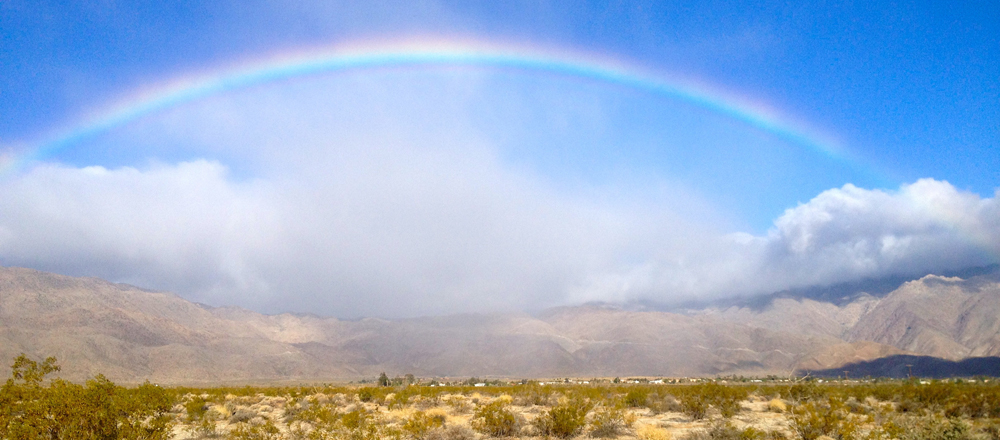
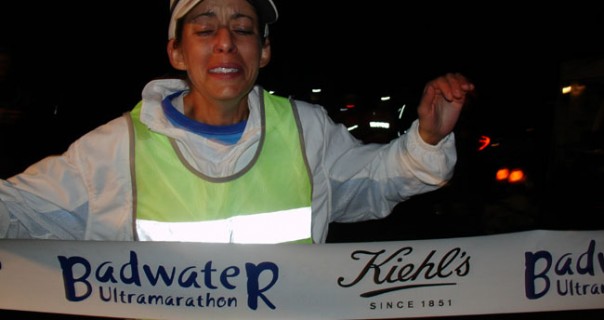
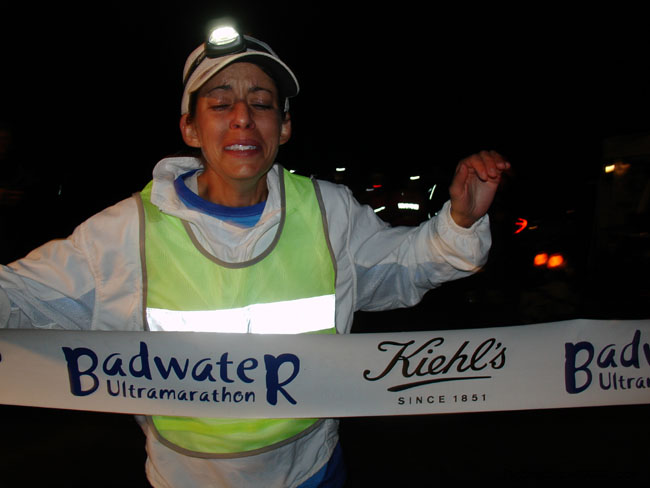
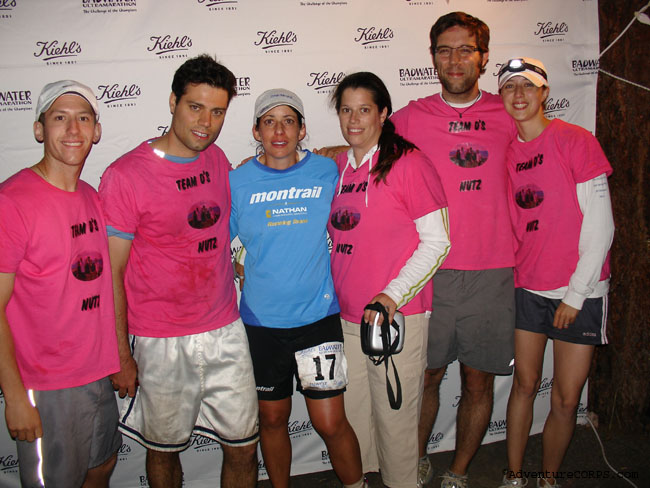
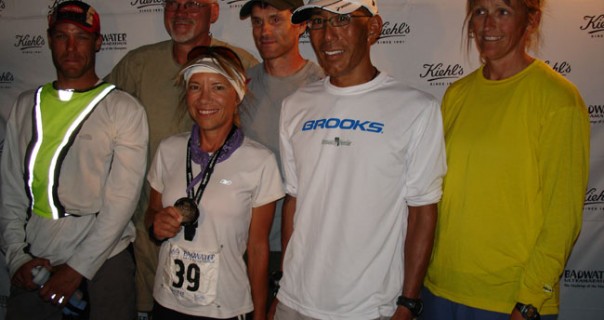
 When Lisa Bliss asked me to be a part of her Badwater team in 2007 I accepted her offer without hesitation. She is someone who immediately gained my trust, put me at ease and accepted me for who I am without judgement. She saw through all of the barriers and disguises that I put up and looked directly into my heart and saw things that others missed. She is a very nice person who gives everyone a chance.
When Lisa Bliss asked me to be a part of her Badwater team in 2007 I accepted her offer without hesitation. She is someone who immediately gained my trust, put me at ease and accepted me for who I am without judgement. She saw through all of the barriers and disguises that I put up and looked directly into my heart and saw things that others missed. She is a very nice person who gives everyone a chance.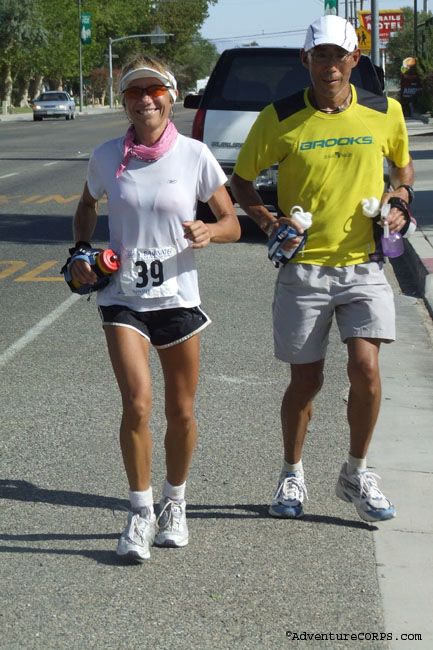 Lisa had just taken over second place when I started pacing her and my goal was to keep her relaxed and focused. I wanted her to focus ahead and not behind. This was not an easy task because Noora’s crew vehicles had to come right alongside of Lisa to park to wait for their runner. This led both Lisa and I to believe Noora was right on her tail and truthfully maybe she was. I refused to look back so I honestly do not know how close Noora was at the time. It was all strategy and tactics from here on out, don’t smile at your competitor, don’t acknowledge her or her crew but instead run forward looking strong and confident. That’s a winning attitude and something that will build confidence and allow you to run with authority and not in fear.
Lisa had just taken over second place when I started pacing her and my goal was to keep her relaxed and focused. I wanted her to focus ahead and not behind. This was not an easy task because Noora’s crew vehicles had to come right alongside of Lisa to park to wait for their runner. This led both Lisa and I to believe Noora was right on her tail and truthfully maybe she was. I refused to look back so I honestly do not know how close Noora was at the time. It was all strategy and tactics from here on out, don’t smile at your competitor, don’t acknowledge her or her crew but instead run forward looking strong and confident. That’s a winning attitude and something that will build confidence and allow you to run with authority and not in fear.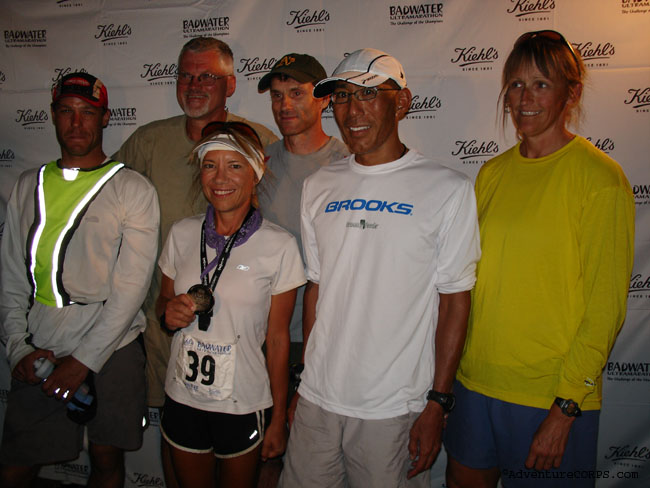 Glenn paced her the next three miles before Lisa looked over to me and asked if I was next. I jumped at the opportunity and melted like butter when Lisa expressed her appreciation for all of my help. Any hurt feelings I had were now gone as together we walked up the three steep switchbacks that led up the mountain. I continued to walk with her until we reached the 1.5-mile to go marker at which point Larry took over for the next half mile. Dave took the final leg with Lisa to the finish as the rest of us waited patiently for her to arrive. At 8:33 Pacific Standard Time Lisa Bliss crossed the finish line and became the 2007 Badwater ladies champion in 34:33.
Glenn paced her the next three miles before Lisa looked over to me and asked if I was next. I jumped at the opportunity and melted like butter when Lisa expressed her appreciation for all of my help. Any hurt feelings I had were now gone as together we walked up the three steep switchbacks that led up the mountain. I continued to walk with her until we reached the 1.5-mile to go marker at which point Larry took over for the next half mile. Dave took the final leg with Lisa to the finish as the rest of us waited patiently for her to arrive. At 8:33 Pacific Standard Time Lisa Bliss crossed the finish line and became the 2007 Badwater ladies champion in 34:33.